Table of Contents Show
Boy meets boy, who meets boy, who meets boy. Then all four boys stumble their way into a polyamorous relationship! This is the love story of Boyfriends, a webcomic written and drawn by Ray Pratiwi, also known as Refrainbow. It’s not exactly a traditional love story, rather it’s a love story that intentionally breaks down traditions and the heteronormativity and cisnormativity they uphold.
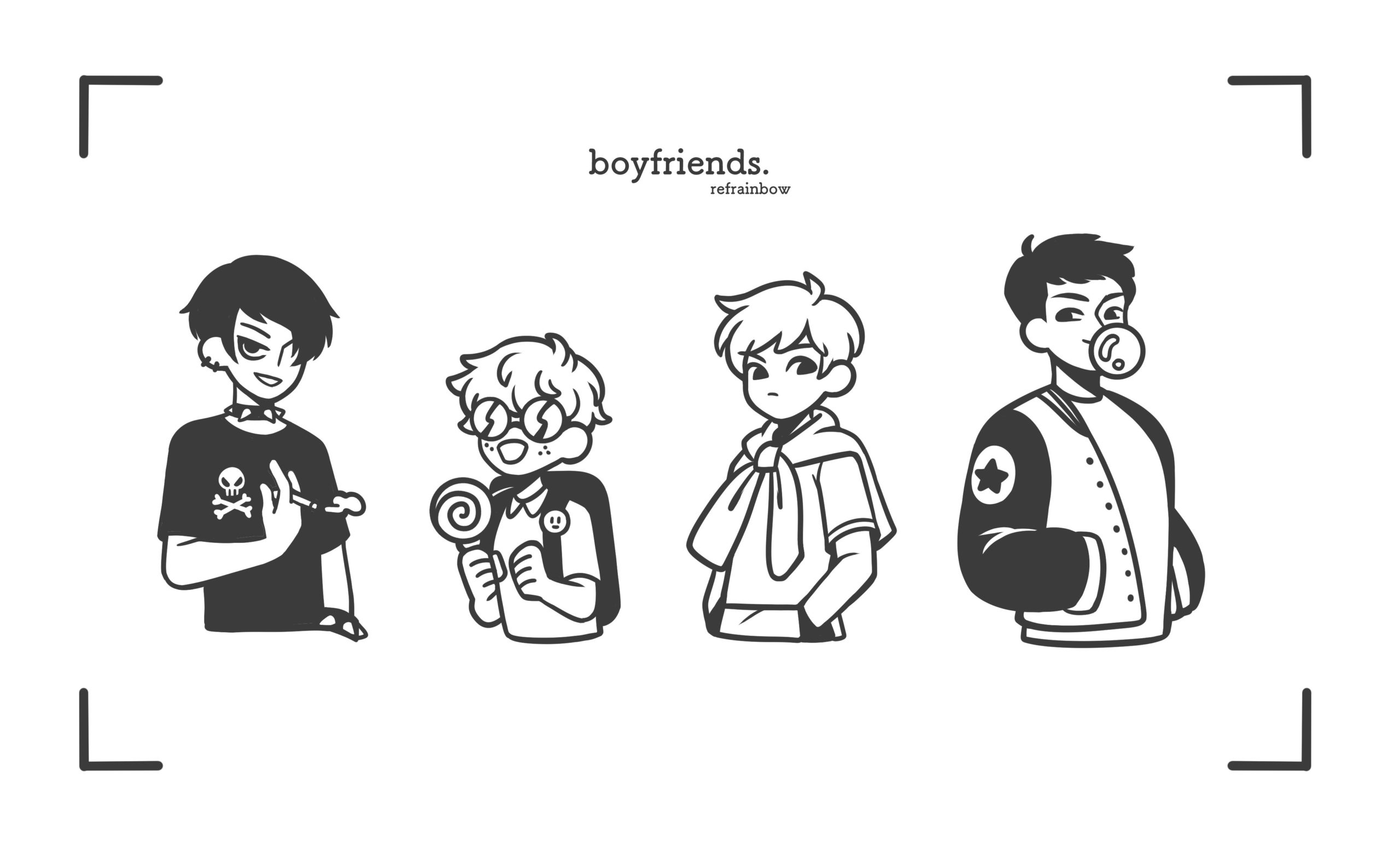
Heteronormativity is the belief that heterosexuality is the default sexuality and that everything besides that is abnormal and/or requiring explanation. According to Gayle Rubin, cultural anthropologist and theorist of sex and gender politics, heteronormativity empowers a specific type of heterosexuality. Straight people who are monogamous, married, and procreative are considered the normal practice of heterosexuality. (( Rubin, Gayle. 1984. Thinking sex: Notes for a radical theory of the politics of sexuality. In Pleasure and Danger, edited by Carol Vance. Boston: Routledge. )) Cis-straight people also experience privileges in a cisnormativity society. Cisnormativity assumes that everyone is cisgender, meaning that their gender and sex “match” according to socially constructed rules about gender and sex. (( “Definition of ‘Cisnormativity.”))
Media reinforces these beliefs with love stories featuring a cisman and ciswoman falling in love, having a closed marriage, and having kids. Whether its an American live-action or shoujo manga, cis-straight couples with monogamous relationships are the stars of nearly all romances. Even when media creates queer romances between two men or two women it can still be cisnormative, and can demonize or fetishize non-monogamous practices if it doesn’t ignore the polyamory all together.
Reinfrainboy’s Boyfriends challenges this long-standing history by creating a series that has the tropes beloved by fans of a cheesy rom-com and a heart-fluttering shoujo manga, but none of the typical romantic leads. With their poly rom-com, they break the rules right off the bat by having more than two romantic leads! They even challenge the cisnormativity present in many queer webcomics/comics/manga with their inclusive portrayal of trans characters. Thus, Boyfriends provides the happy rom-com that is missing from the media. So, let’s jump into Boyfriends, the queer poly rom-com with trans representation that everyone should be reading.
Meet The Boyfriends
Boyfriends follows the polyamorous love story of Goth, Prep, Nerd, and Jock. They are all students at a university. Goth and Prep are college seniors and childhood friends who are living together while attending school. While Goth harbors a long-time crush on Prep, oblivious Prep thinks their relationship is a typical friendship. This is despite the fact that the friendships includes a history of regularly making out and having sex. However, according to Prep this is just what “bros” do.
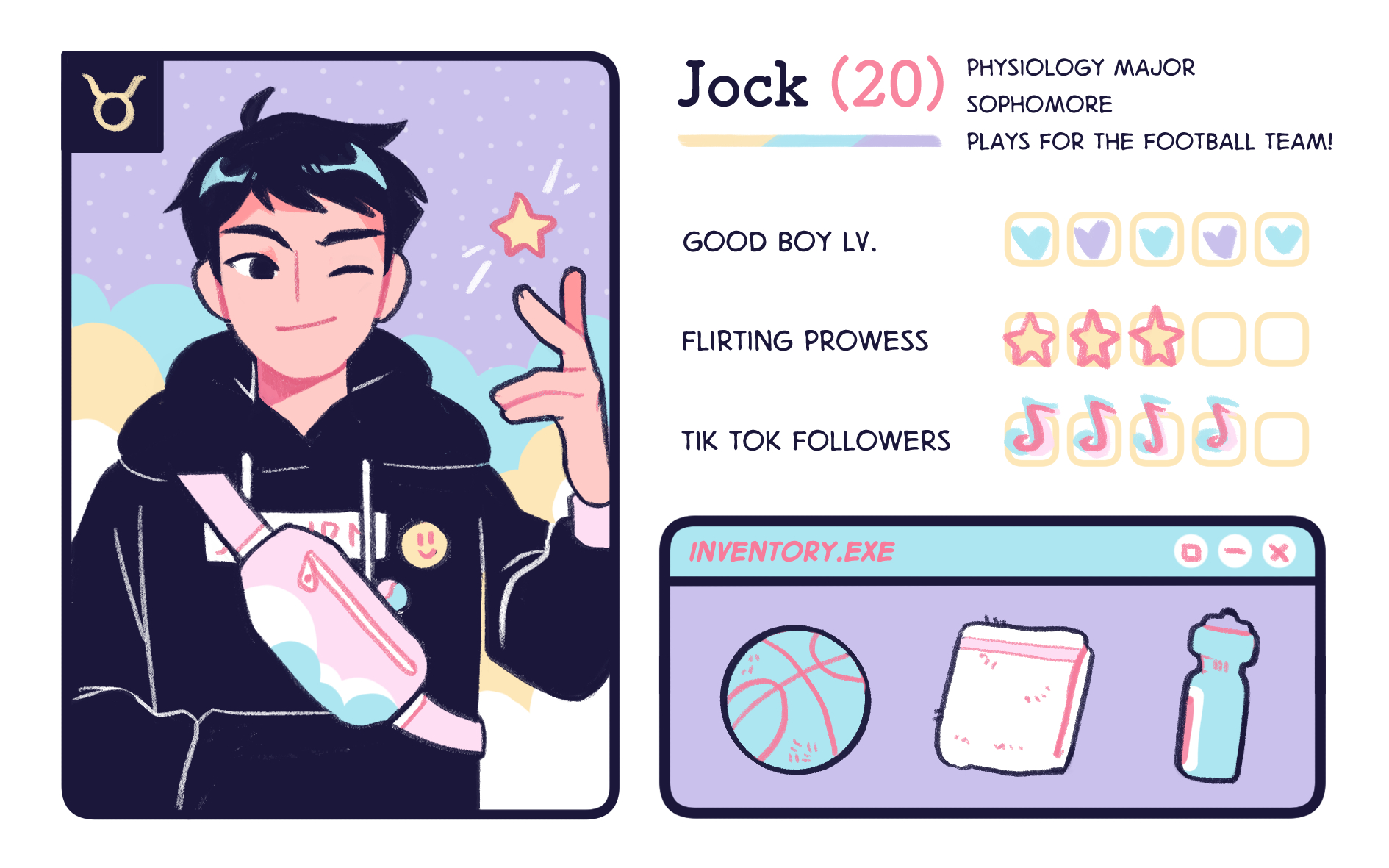
While Prep complains about being single, Goth decides to tease him and get the number of a cute boy walking near them. This is how Goth meets Nerd. Nerd is an anime-loving freshman who is clumsy, but still very direct about his desire and naughty thoughts. Later, Prep trips in the hallway and is caught by Jock, who then asks Prep out. Unfortunately, it takes Prep several hours after rejecting him to process the invitation as a flirting. While Prep and Jock try to recover from their awkward meet-cute, both of them meet Nerd and find him dangerously adorable. Jock also hits on Goth just to learn Goth might be more than he can handle, which he finds very attractive.
While Jock and Prep try to figure out their misunderstanding, Goth and Nerd discuss their relationship. After Nerd explains he likes Goth but also likes Prep and Jock, Goth admits he feels the same way. The two become an official couple and work together to entice their crushes into joining their relationship. After Jock and Prep begin dating, they feel conflicted because while they like each other very much and are happy to be together, they can’t keep the other boys off their minds. The chemistry between these four finally draws them together and they decide to enter into a polyarmous relationship. The fact none of them have any experience in polyamory doesn’t stop these boyfriends!
Playing With Classic Characters
The romantic leads of this webcomic are named after teen archetypes, but they are introduced in new ways. Take a look at Nerd. The nerd character is typically not smooth, not experienced with romance and/sex, and not someone people would instantly describe as attractive. If they are romantic leads, they often undergo a transformation before ending up with the romantic lead that is “out of their league.”
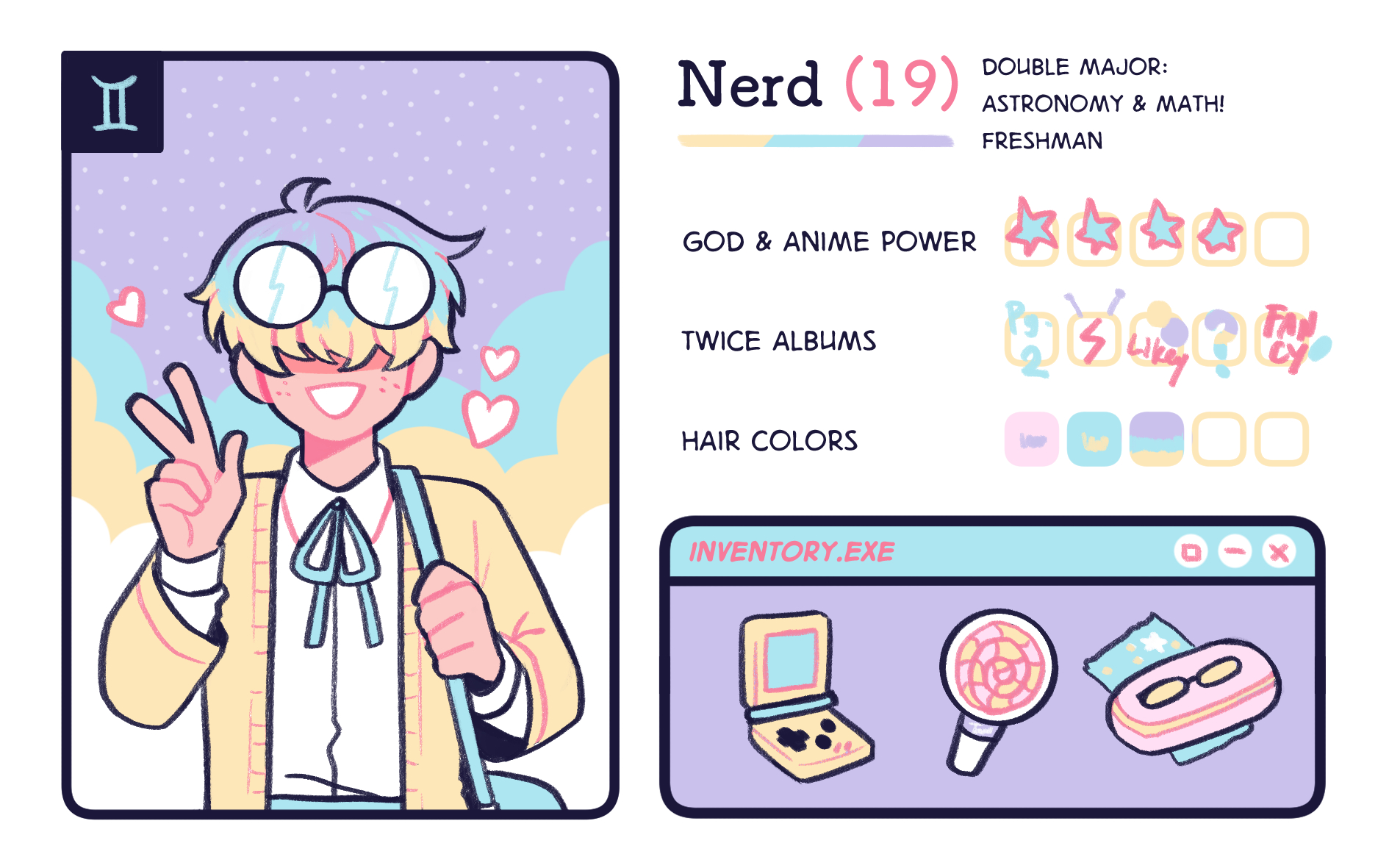
Nerd defies all these past tropes by being the adorable heart-breaker that he is. He might become flustered easily, but he can also easily make the first move. He might be less experienced, but he’s not shy or embarrassed by it which show’s he’s eager to learn. He’s also pansexual when the nerd trope is traditionally crazy about just girls. He’s still undeniably nerdy, but his hobbies and fashion don’t restrict him to an old trope.
Then there’s Jock, who might look like your typical jock, but definitely isn’t. Historically the jock archetype varies a bit depending on whether they are the antagonist or protagonist, but they are typically popular teens who are social, don’t do well in school, and are used to getting attention. They’ll also be romantically and sexually experienced. In LGBTQ+ stories, jock love interests are closeted and will overcompensate to maintain a “macho straight man” appearance. Jock is an openly bisexual man who doesn’t worry about masculinity, he’s even comfortable learning and teaching female K-pop dances. He’s a flirt who hits on Goth, Nerd, and Prep on separate occasions, but also someone who easily becomes bashful and flustered when Goth and Nerd make the moves on him. He’s a silly and bashful gentleman who doesn’t care about his reputation.
Preppy characters are wealthy, posh mean boys who might be antagonists or the love interest depending on the story. In both cases, they often bully their working-class love interest, becoming more kind and gentle as they fall in love with the protagonist. Prep might be wealthy, but he’s not an arrogant elitist because of it nor does he display a sense of entitlement. He might look posh, but he’s really just a clumsy and clueless prince that doesn’t realize how popular or how spoiled he is. While he’s used to being pampered by Goth and later his boyfriends Nerd and Jock, but he doesn’t demand it nor act bratty when he doesn’t get it. Prep has none of the arrogance, malice or entitlement that the typical Prep character, but it’s still obvious that he’s a pampered idiot.
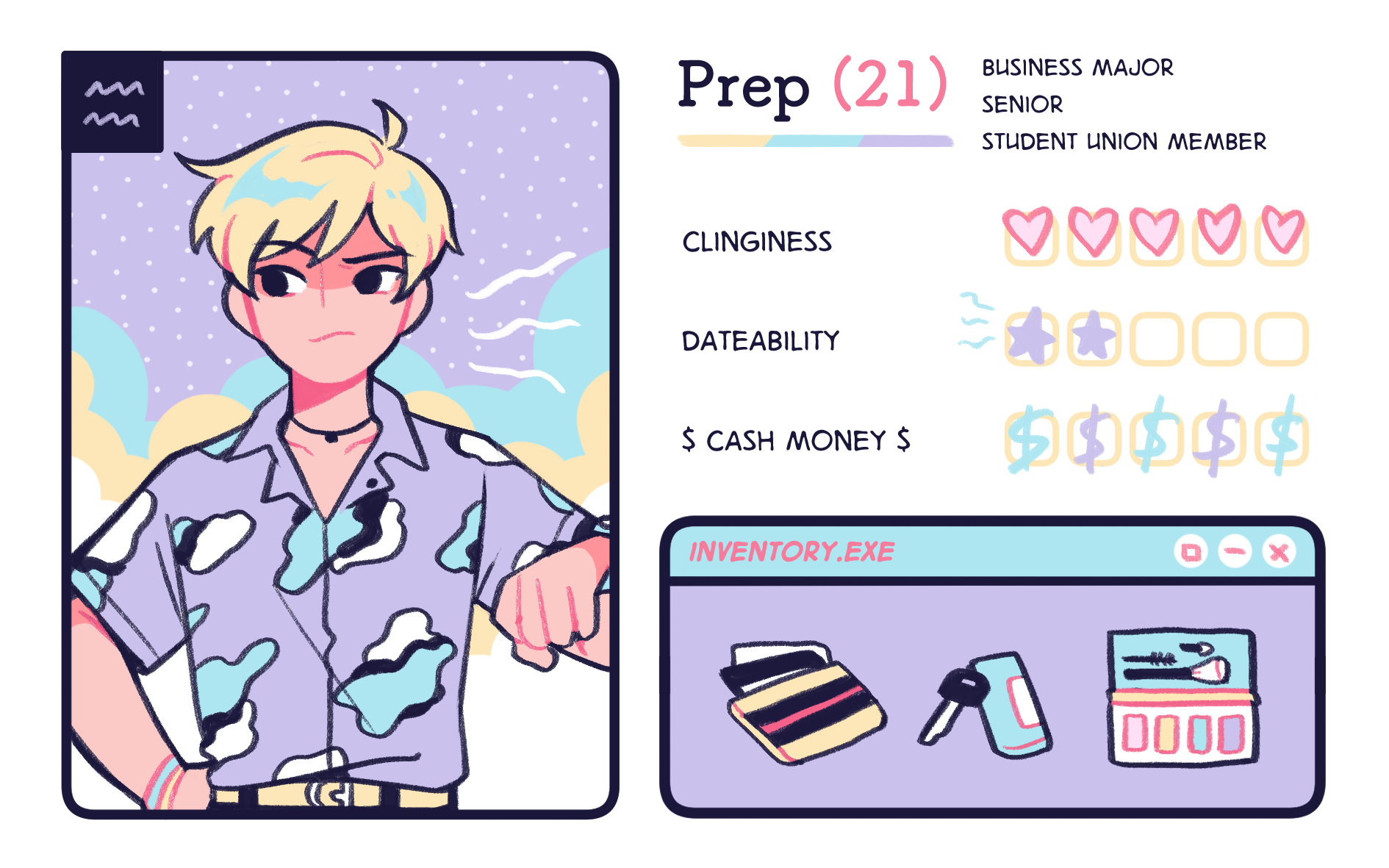
Finally, there’s Goth, who might be the most similar to the archetype but who still deviates from it. Goths in fiction are snarky, deadpan artists who take great pride in their appearance and art projects. They are not goths just in appearance, they are invested in Gothic books, music, films, and art. They wear black and leather and listen to loud depressing music. Goths in fiction are often cartoon versions of real goths, who vary in personality. Goth’s character shows people how goths are not all one type of personality. He’s an artist who does wear all black and is involved in the goth culture, but he’s not snarky or deadpan. He’s a playful, flirtatious, and smooth heartthrob. He likes watching anime and online gaming. He spends time with his goth friends, but he’s not cliche like goths in fiction often are. He loves his preppy, athletic, and nerdy boyfriends and accepts them all for who they are.
They are still the classic love interests that readers fall in love with, but they break old stereotypes and become characters that are more complex and interesting to read about. Additionally, these tropes are rarely seen within an LGBTQ+ context, let alone a polyamorous one.
Rejecting Regular Romances
Boyfriends provide rare poly representation while also educating readers unfamiliar with non-monogamous relationships and deconstructing toxic ideas about romance, including toxic monogamy. It thus provides readers with a poly rom-com with healthy relationship practices that aren’t as normalized in the romance genre.
Poly Representation
Poly ships are nothing new to fandoms. Fans have been writing poly and making poly fanart for poly ships that never become canon. While there is a demand, there are few instances of actual polyamorous relationships in fiction. This may be due to the normalization and acceptance of monogamy as the default and toxic monogamy ideas.
In addition to reinforcing monogamous straight relationships as the default, media also plays a role in the reinforcement of toxic monogamy. Toxic monogamy refers to monogamy as a cultural institution that has been interpreted and practiced in ways that are unhealthy and nurture codependency. Toxic monogamy normalizes jealousy, demanding your partner fulfill all your emotional and social needs, and that love can overcome any difficulty or complication. It also normalizes the belief that if you truly love someone, you won’t be attracted to anyone else.
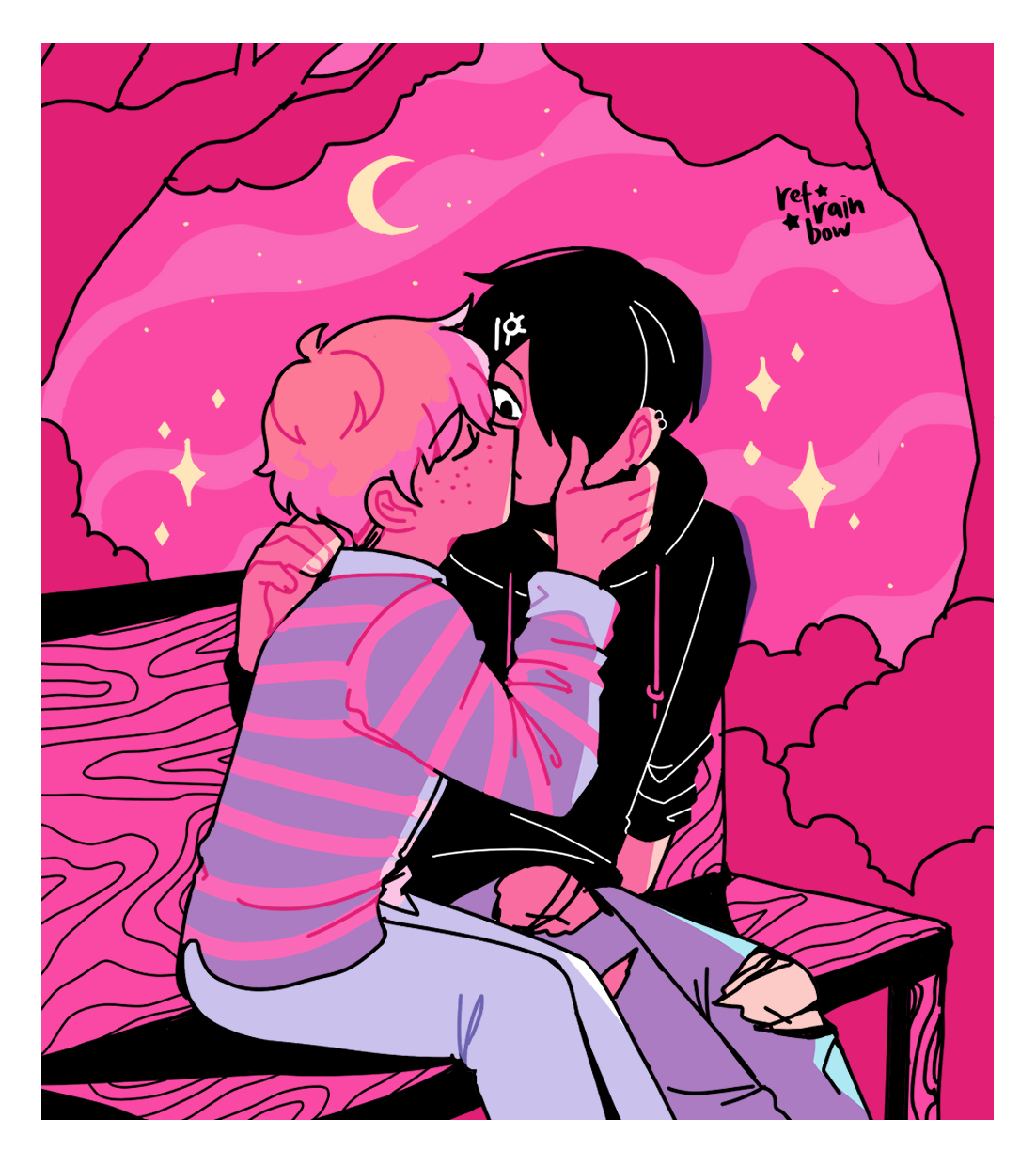
In the media, this is normalized with a couple storylines. If a character is attracted to someone besides their partner, it becomes a conflict or a comedic moment. The character is either going to break up with their partner or apologize to their partner and recommit to them. Or the character is presented as the idiotic unfaithful partner who is simply incompatible of monogamy. The idea that it’s okay to be attracted to someone besides your partner is never really a plot point. Nor are their storylines in which couples discuss the possibility of some non-monogamous practices. The exclusion of these ideas normalizes toxic monogamy and the belief that anything besides monogamy is deviant and other.
In realty, all relationships, whether they are monogamous or polyamorous, have to accept that their partners may find someone else attractive. Whether the person acts on that attraction or not depends on the couple. In all cases, people need to talk to their partners and decide what is best for them. Boyfriends normalize these discussions and demonstrate how they can naturally lead to a poly relationship.

Boyfriends normalizes polyamorous relationship first with Nerd and Goth. When Goth asks if Nerd would like to make their relationship more official and they accept that they’re also interested in Jock and Prep, they both accept that sometimes this is what love looks like. They both want it to be quad and work together to court the other two. A pair flirting with another person is rarely seen in media beyond the married couple looking for a threesome to revitalize their own sex life. Refrainbow shows the readers what it could look like when a pair are romantically pursuing other people not to improve their life as a couple, but to change their status from couple to something else.
In addition to normalizing wanting a poly relationship, Refrainbow challenges toxic monogamy with Prep and Jock. When Prep and Jock start dating, their attraction for Goth and Nerd don’t fade away, which causes some discomfort. In these moments they are comparing themselves to the unrealistic standards of toxic monogamy. They also are assuming that monogamy is the only type of romantic relationship they could be in.
Independently of each other Prep and Jock decide they need to talk. In an honest conversation, they reveal their attractions and what they would like to do. This is an important example for readers, teaching them instead of feeling guilty they should discuss with their partner what they should do if the crush is significant. Prep and Jock could have decided to break up or to acknowledge their crushes but not act on them. However, because this isn’t the usual monogamous story, they decide to act on their crushes together; and more honest communication ensues!
What A Healthy Relationship Look Likes
While rom-coms are usually filled with examples of unhealthy relationships and inappropriate behaviors, Boyfriends demonstrates the importance of communication and boundaries within a relationship. When all four boys confess their feelings, they decide to sit down and set up some boundaries. It’s a simple and casual scene but teaches readers that poly relationships are real relationships that require the same honesty and respect. Poly relationships are often portrayed negatively and understood as people doing whatever they want without needing their partner’s permission. This isn’t true, any relationship needs to discuss what their partners are and aren’t comfortable with.

Honesty and respecting boundaries are the foundation of all healthy relationships, whether they involve two or five people; Boyfriends shows readers the importance of this type of communication. For example, Prep explains he is only comfortable with being physical with these three boys and would also prefer they were only intimate with each other, essentially asking for a closed relationship between the four of them. Goth agrees that they need to all consent to the status of their relationship before moving forward. Additionally, they also talk about having sex and what each of them is comfortable with. Nerd confides he is a virgin and they reassure him that they will go at his pace. The chapter in which they officially become a quad emphasizes the importance of boundaries and communication, the details aren’t glossed over. The reader not only learns about poly-relationships but relationships in general.
By including this conversation while keeping the general light-hearted tone of the series Refrainbow demonstrates that rom-coms can be silly or sexy without romanticizing toxic behaviors. After they’ve established themselves as a quad, Refrainboy gives them all the rom-com cliches and shoujo manga moments reserved for straight, monogamous couples. It has the meet cute, the staple scene of rom-coms in which the romantic leads meet for the first time.
Boyfriends has three meet cutes in fact! One of them is the classic “falling into his arms” trope often seen n romances. Goth and Prep are also the childfriends to lovers trope, a classic romantic plot found in shoujo manga and rom-coms. Prep is the oblivious love interest that is found throughout the shoujo genre. There’s also the kiss on a Ferris wheel, a scene romance fans have seen in k-dramas and shoujo manga. There’s also the first kiss, a memorable occasion in any romance. This series has multiple first kisses. It has so many classic and cheesy moments that make the genre beloved but giving them to a group of characters that haven’t gotten them before.
Transmen In Boys Love Comics
Boyfriends doesn’t just deviate from the traditional straight romances, it also deviates from gay romances with it’s positive transgender representation. Boys Love (BL) comics and yaoi manga both center around the romantic and/or sexual relationship between two men. Neither have the best track record on transgender representation with it’s exclusion of transmans and it’s portrayal of transwomen.
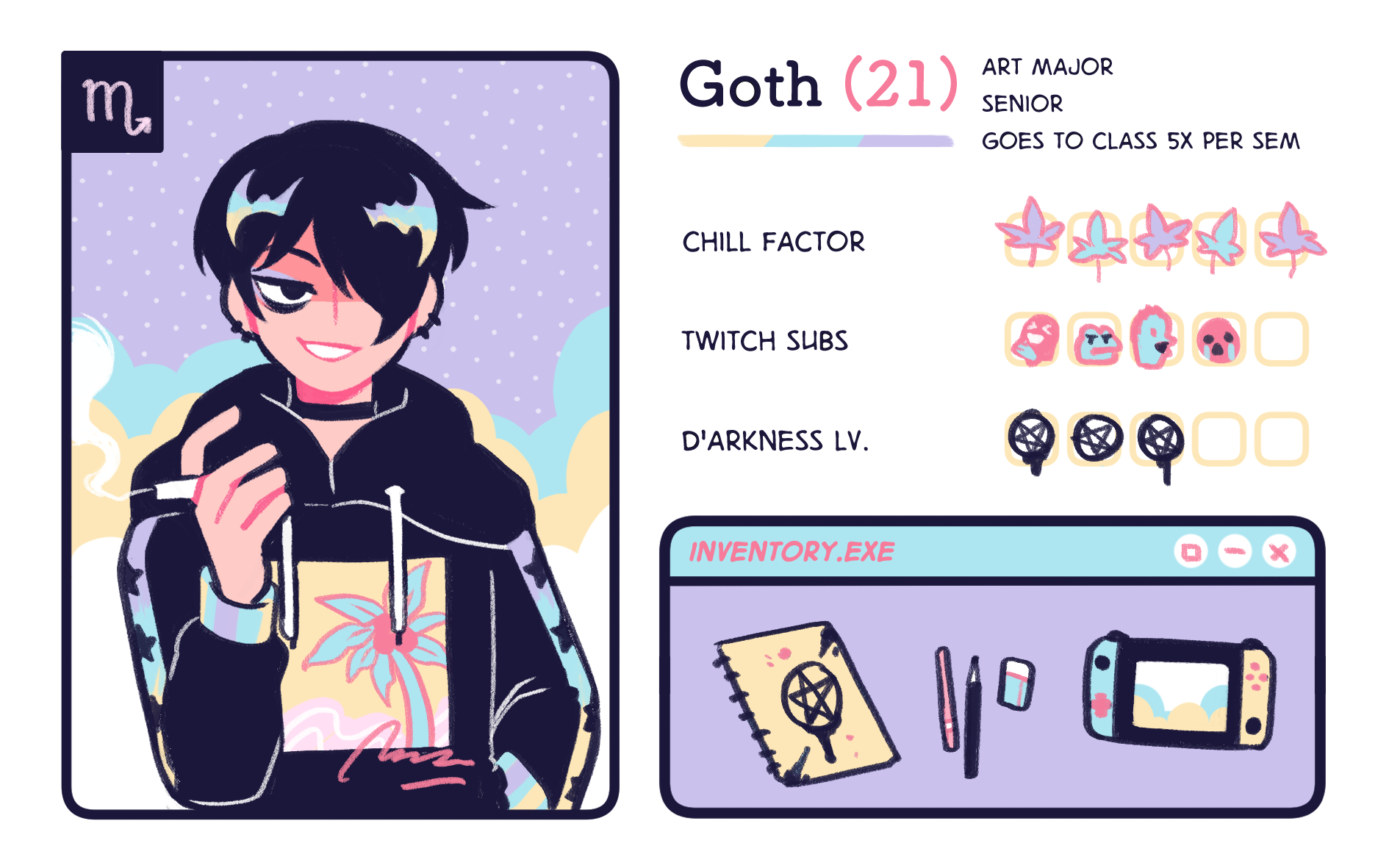
Bl comics and yaoi manga rarely have transmen as romantic leads or even as side characters. They sometimes feature characters that could be considered transwomen, though the writers never present them as such. They are either cismen who enjoy dressing as women but don’t identify as women or males who identify as women. Both types of characters are referred to as “traps” and are both treated like men who are preying on straight men, a homophobic and transphobic portrayal of both transwomen and men who crossdress. Unfortunately, it is still the most common representation of transgender individuals in BL comics and yaoi manga. Thanks to creators like Ray, this history is being challenged.
Goth is a transman and a romantic lead. He is treated with the same care and love as all the other the characters, annd he’s never reduced to one aspect of his identity. Characters that are minorities in a genre are often defined by the trait that makes them different. The result is a one-dimensional character that feels like an act of tokenism rather than inclusion. Goth is never defined by the fact he is a transman; the readers don’t even discover until Prep says he’s known Goth since before he transitioned in a bonus chapter. Additionally, Goth’s identity as a gay man is never questioned nor is he treated as less than a man or different from the others. Goth is Goth. He’s a smooth talker, he knows how to treat a boy right, and he’s hard to get the better of. He’s gender identity and his sexuality are just one part of this character and his inclusion in a BL webcomic is significant.
Romcom Magic For Everyone
Refrainbow’s Boyfriends explored the rom-com genre in a new way, creating content for people who haven’t seen themselves in fictional love stories. Boyfriends is a poly BL romance with positive transgender representation, something entirely new while being familiar at the same time. The characters are even named after character archetypes, except they’re a little different because they aren’t restricted to any traditions regarding gender and sexuality.
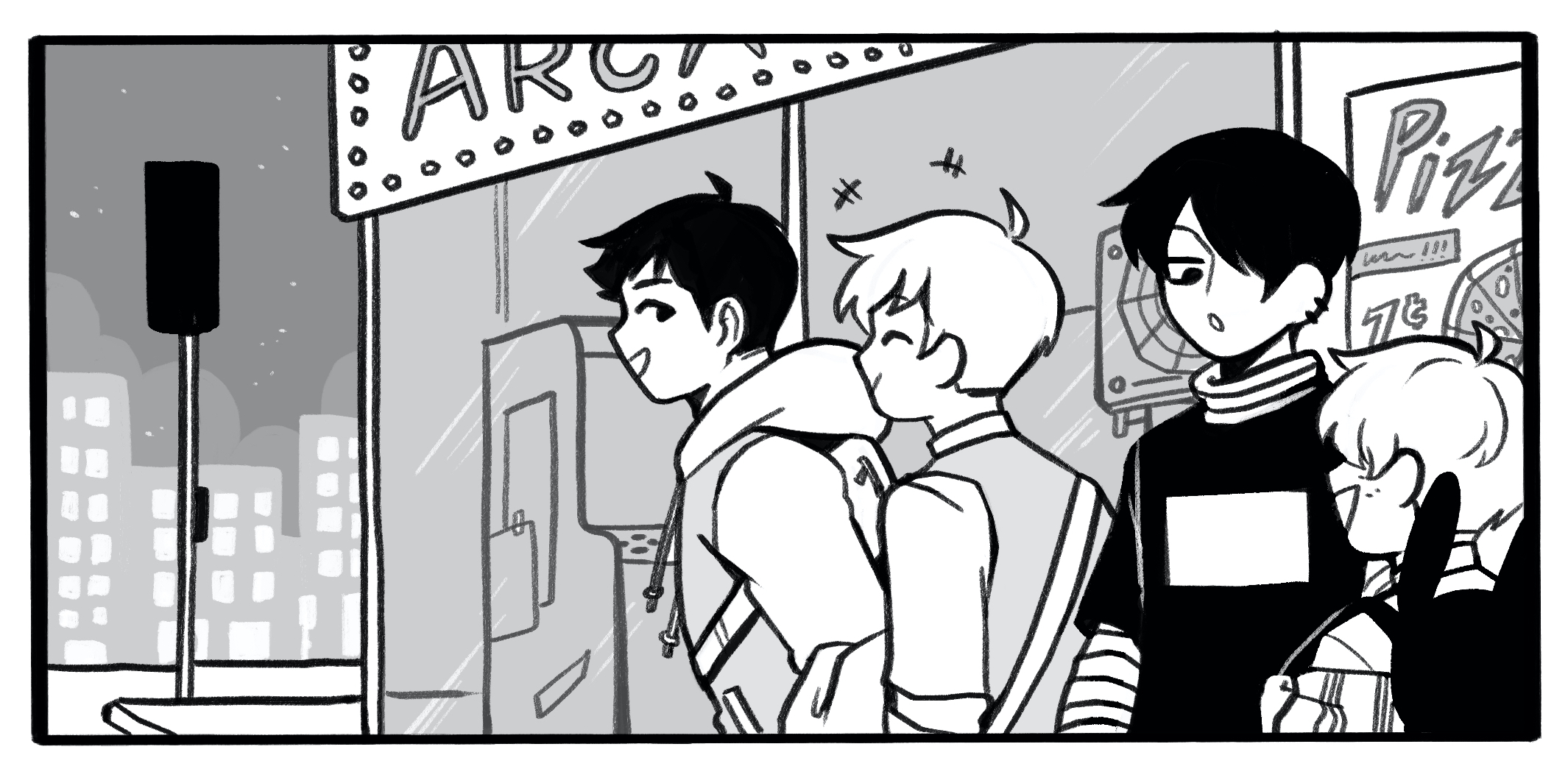
At the end of the day, what makes boyfriends so enjoyable is that it’s so carefree and fun. It’s not letting anything restrict it; it’s just some boys falling in love and being undeniably adorable.
Interested? You can read Boyfriends on WEBTOON and Tapas. Follow Refrainbow on Twitter and Instagram. If you really love the story and have the financial means, become a Patreon or buy them a coffee on Ko-fi.
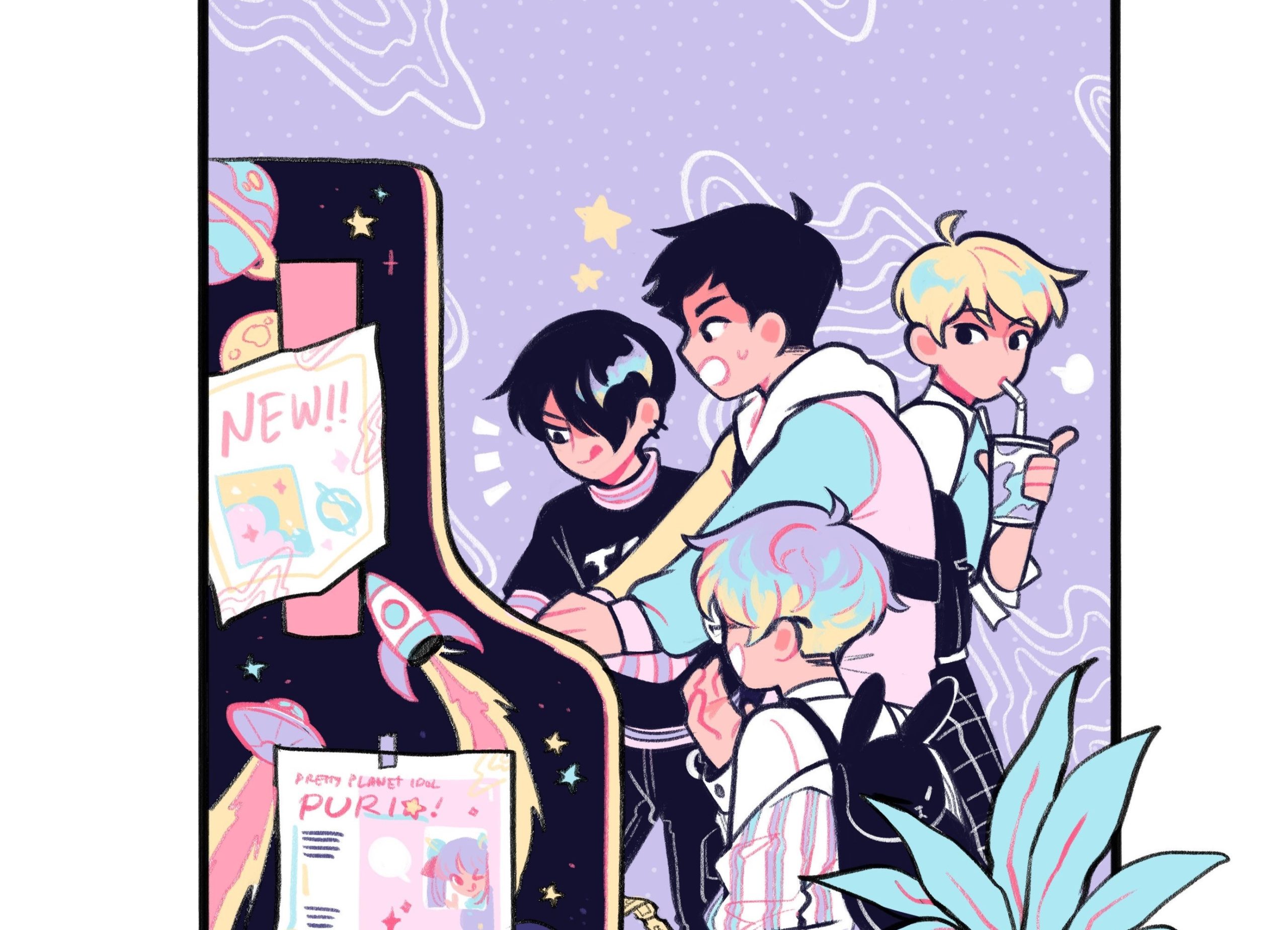
I’m in love with art style! Thank you for recommendation & for a great review – definitely going to check it out!